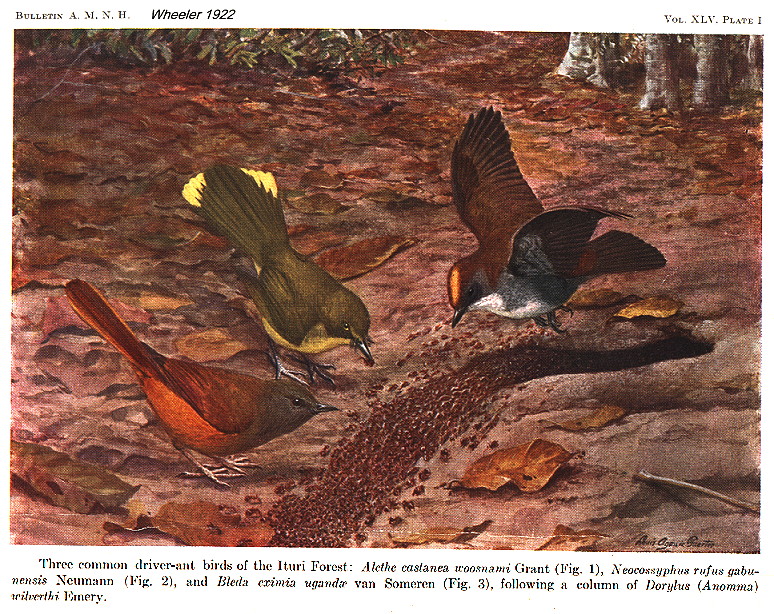SUBFAMILY DORYLINAE - Genus Dorylus
Subgenus Anomma - Introduction
| The Ants of
Africa SUBFAMILY DORYLINAE - Genus Dorylus Subgenus Anomma - Introduction |
|
| Genus Dorylus and Key |
 |
Subgenus Anomma Shuckard (1840c: 326)Diagnostic Features - Antennae with 11 segments and at least some joints of funiculus longer than width. Pygidium impressed with sharp margins. |
|
Analysis of present knowledge, with a key to species and to a comparison of the gastral apices - Anomma keys |
|
General summary
Particularly curious are the huge wingless dichthadiigyne queens and the bizarre "sausage fly" males. |
|
The first description of an Anomma species was of a male specimen in 1802 (Dorylus nigricans Illiger) long before the Driver Ant workers (Anomma burmeisteri Shuckard, 1840c) and remaining unassociated with the Driver Ant workers for another decade (Anomma rubella, Savage, 1850). Uncertainty over that association of males with workers since has been cast into doubt by the work of Raignier & van Boven (see below), who reported that males of one species could be found accompanying, or at least very close to, trails of workers of a clearly distinct second species. The queen was first described by E. André, in 1900, under the name Anomma nigricans [Sur la femelle probable de l'Anomma nigricans Ill. (Hym.) Bull. Mus. Nat. Hist. Paris, 6, 364-368] but Wheeler (1922) had this as the queen of Dorylus wilverthi, and it was not listed by Bolton (1995). Specimens photographed by Raignier & van Boven (1955), together with workers I have scanned, are shown left. Raignier & van Boven were the first to find all three life stages, of Dorylus wilverthi, in a single nest, possibly even today this is the sole finding of all forms together for a single species. |
|
NOTE - it seems from Raignier & van Boven (1955) that only one species, Dorylus (Anomma) wilverthi, can be definitively stated as having all three life forms, male, female and workers, collected together from a nest (by them). They described how the finding of dealated males in migrating columns does not guarantee the males are associated with the workers in the column, instancing an occasion when they found a male of Dorylus (Typhlopone) in a wilverthi column. Thus, what from the literature appears to be perhaps the best known and most widespread member of the subgenus, Dorylus (Anomma) nigricans Illiger, actually is definitively known solely from the male. The vast majority of the references to "nigricans" most probably should be given under the definitive name of the worker described as Dorylus (Anomma) burmeisteri by Shuckard (1840c: 26). Raignier & van Boven (1955) also emphasise the problem with evaluating the merits of the numerous descriptions of varieties made by the early taxonomists. Differences in colour were used to justify descriptions of new "varieties", such as pallidus and rubellus, but often the author had seen only one or very few specimens. Raignier & van Boven described how, in their studies of colonies in the field, it was not uncommon to see pale specimens, simply because the individual ants were not fully matured. To illustrate this, the illustration (right) shows several specimens taken by Professor S. Uehara from a migrating Driver Ant column at Mahale in Tanzania. As always - a picture is worth a thousand words! |
|
Note on "Dorylus (Anomma) nigricans Illiger" Bolton (1995: 179) gave a blanket list of the following under
the main species name nigricans :- The species was named solely from a male specimen, with no
associated worker or queen stages. Some light on the situation may be
in the Haldeman (1849a) paper on Savage's collection of rubella
"red drivers" from Gabon, with a column amongst which were three males;
this is at Emery (1895j: 706) had a short key separating the workers
using :- Wasmann (1904b) reviewed Dorylus (Anomma) nigricans
Ill. subsp. burmeisteri Shuck. and what he regarded as the then
known varieties. This is at |
| Genus Dorylus and Key |
© 2007, 2011, 2012, 2014 - Brian Taylor CBiol FSB FRES 11, Grazingfield, Wilford, Nottingham, NG11 7FN, U.K. |
href="anomma.htm"